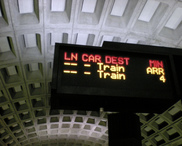More 8-car trains could save money and preserve capacity
One of WMATA’s proposed cuts to rail service involves discontinuing 8-car trains entirely. That’s the most harmful of the rail service cuts. Instead, they should consider the reverse: running more 8-car trains at peak times.
Metro says shortening all 8-car trains to 6 cars will save $2.688 million for the year. That’s based on savings in propulsion power minus lost farebox revenue resulting from decreased capacity.
As Craig Simpson noted, the “return on divestment” here is not particularly good — Metro would only save $1.76 for each $1 lost. In fact, it’s the worst savings to loss ratio of all the proposed rail cuts, worse than most by far.
This isn’t much of a surprise. At peak times the Metro system is already at capacity in some places. Because of this, cutting peak capacity is the most direct way to cut ridership, because you can be fairly certain those cars not running would have been full.
Metro has acknowledged that shortening trains to 6-cars reduces peak pull out by 58 cars, a whopping 7% of peak capacity. According to Metro as of April 2009, the system was running a total of 850 cars during peak service.
232 of these constitute the 29 8-car trains, leaving 618 cars to make up 103 6-car trains, for a total of 132 trains. 8-car trains cost more to run than 6-car trains because they require more propulsion power, but the increased cost is proportional to the increase in capacity, meaning the cost per passenger-mile is unchanged. Essentially, it costs the same to move 850 cars through the system regardless of train length.
If Metro maintains peak capacity but eliminates trains by cutting some 6-car trains and lengthening others to 8 cars, they stand to reap several benefits. First and foremost, Metro could reduce its labor costs, which make up nearly 75% of the proposed 2011 Metrorail budget (page 75). As mentioned above, the cost of moving all 850 cars through the system is essentially constant, except for one thing: the operators.
If Metro were to run 104 8-car trains, and 3 6-car trains, the most 8-car trains possible with an 850 car fleet, the peak service would only require 107 trains, 25 fewer than now. Assuming the average Metro salary of $76,036 (many operators make significantly more), 25 fewer operators translates to $1.9 million in savings per year. Add in estimated fringe costs of $29,831, and Metro saves another $750,000 each year.
Running fewer total trains also means Metro could increase headways slightly during the crush time, allowing for more dwell time in the busiest stations, and reducing problematic pile-ups at choke points which reduce average speed on lines and end up costing the agency in performance and money. A 19% reduction in trains may sound extreme, but during peak service, it would have a relatively small effect on customer experience: 2.5 minute headways would widen to 3:10, 3 minutes to 3:45, and 5 minutes to 6:20.
Of course, ridership is not totally even across the peak hour. There may be times when 8-car trains and longer headways might be more harmful than helpful. Still, with the right mix of train lengths, but more 8-car trains, rather than fewer, Metro should be able maintain peak capacity while saving some costs.
As I understand it, Metro has previously experimented with fewer total trains but more 8-car trains on the Orange line as a way to reduce congestion in the Rosslyn tunnel. Because 8-car trains were relatively new at that time, there was no Automatic Train Operation (ATO) setting for berthing 8-car trains in stations, and operators were inexperienced with manual operation of the longer trains and had trouble efficiently berthing them correctly. The result was actually less efficient service.
When Metro abandoned the experiment, they expected to try again once ATO berthing for 8-car trains had been perfected. Meanwhile, most of the concerns at that time became moot.
Since the Red Line Crash last June, ATO was switched off and all trains are operated in manual. Additionally, all trains now pull to the very front of the station, increasing berthing times regardless of train length.
Finally, 8-car trains have been part of the Metro fleet for several years now, meaning that most, if not all operators have significantly more experience operating them manually than they did previously. The result is that Metro should actually be able to increase its peak service reliability, particularly on the Blue-Orange and Red lines, by decreasing the total number of trains.
Metro would probably incur some extra costs based on the need to reconfigure trains for off-peak service, but even if this cost amounted to $1.5 million it would still be a more efficient way to cut costs than cutting 8-car trains, and cuts no capacity. Additionally, instead of switching back and forth from 6-car to 8-car trains, which requires extra planning and is labor intensive, WMATA could just go with my next crazy cost-saving method: cut the trains in half and run 4-car off-peak trains. But we’ll save that proposal for another day.

